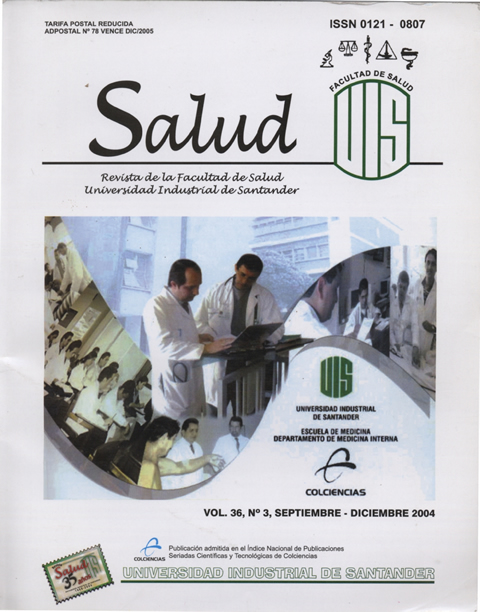Resumen
RESUMEN
OBJETIVO: Determinar características de los pacientes con falla cardiaca del HURGV.
DISEÑO: Estudio descriptivo longitudinal. Serie de casos.
LUGAR: Hospital público.
POBLACIÓN: 218 pacientes hospitalizados desde 1 julio 2002 y 30 junio 2003.
MEDICIONES: Datos demográficos, antecedentes patológicos, compromiso clínico y tratamiento recibido, posteriormente seguimiento durante 12 meses para establecer curso de la enfermedad y pronóstico.
RESULTADOS: Promedio de edad 68, género masculino 51.6%, 68.6% provenientes de Bucaramanga. Clase funcional NYHA III en 63%, factores de riesgo cardiovascular en el 89.4% , HTA en el 73.1%. Otra comorbilidad en el 36.7%; la principal fue el EPOC en un 20.2%. La principal causa de hospitalización fue el subtratamiento (50%). Ecocardiograma disponible en 49.5%, fracción de eyección promedio de 25%, se encontró disfunción sistólica en el 73.2% e hipertensión pulmonar en el 59.3%. El 30% de los pacientes no recibían ningún tratamiento y solo el 6% recibía el optimo. El 16.9% fallecieron durante la hospitalización. Durante el seguimiento 40.8% reingresó, el 23.6% por subtratamiento. El 66% requirió una hospitalización, clase funcional fue III en 59.4%, tratamiento optimo en 9%, el 2% no recibía ninguno. El 31.5% falleció los primeros 3 meses, a los 12 meses fallecidos de 45.2%. Los factores asociados a mortalidad fueron la edad (OR 1.04) y la clase funcional (OR 5.02).
CONLUSIONES : Los pacientes del HURGV son adultos mayores, tienen alta prevalencia de factores de riesgo cardiovascular, no se realizan controles periódicos y presentan una enfermedad severa subtratada y asociada a alta mortalidad.
Palabras clave: Insuficiencia Cardiaca congestiva, Falla Cardíaca, Factores de riesgo, curso y mortalidad.
ABSTRACT
OBJETIVE: To deternine the clinical and epidemiological caractheristics of patients with heart failure in the Hospital Universitario Ramon Gonzalez Valencia.
DESIGN: Longitudinal descriptive study.
SETTING: Public hospital.
PARTICIPANTS: 218 hospitalized patients with heart failure, between July 1/02 and June 30/03 who could provide the required information.
MEASUREMENTS: The data were collected by interview, they were asked about demographic data, conditions associated to the development of heart failure, the severity of the pathology and treatment. Follow up was made during 12 months to know the course of the disease and the factors associated to mortality.
RESULTS: Mean age was 68 years, 51.6% were men, 68.6% came from Bucaramanga and the metropolitan area. Functional class NYHA III (63%), risk cardiovascular factors were present in 36.7% and the predominant was hypertension (73.1%). Another comorbidity 36.7%, the main associate disease was COPD (20.2%). The main cause of hospitalization was lack of treatment (50%). 49.5% was ecocardiografic data, mean ejection fraction was 25%, systolic dysfunction (73.2%), pulmonary hypertension (59.3%). 30% of patients did not received any treatment and 6% received optimal treatment. 16.9% died during hospitalization. During following year, 40.8% return to hospital, 23.6% return for lack of treatment, 66% required at least one hospitalization, functional class NYHA III (59.4%), optimal treatment (9%), 2% did not received any treatment. 31.5% died during first three months, 45.2% died during following twelve months. Factors associated to mortality were age ( OR 1.04) and functional class IV (OR 5.02).
CONCLUSIONS : The population that assist to RGVUH is mainly geriatrical, they have a high prevalence of cardiovascular risk factors, they do not return to periodic controls and they suffer a severe disease that does not receive optimal treatment and it is associate to high mortality.
Key words: Cardiac Failure,Risk Factors, Mortality
Se autoriza la reproducción total o parcial de la obra para fines educativos, siempre y cuando se cite la fuente.
Esta obra está bajo una Licencia Creative Commons Atribución 4.0 Pública Internacional.
